Five years ago, we did a post about Cinémagazine. Cinémagazine-Edition or CE was a small French publishing company, located in Paris, which had a good reputation. Cinémagazine's star postcards from the 1920s and 1930s are still mesmerising. Since then, we found a lot of Cinémagazine postcards which we like to share with you in two posts. In this first post the original postcards of the 1920s, in a sepia brown tone and without a frame.
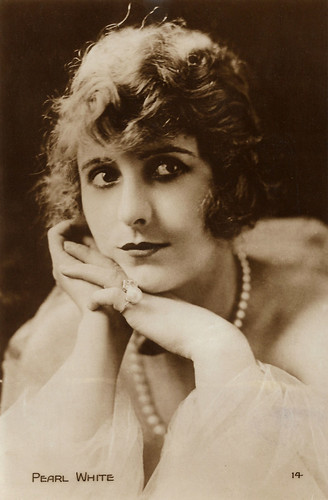
French postcard by Cinémagazine-Edition, Paris, no. 14.
Pearl White (1889-1938) was dubbed 'Queen of the Serials", and noted for doing her own stunts, in silent film serials such as The Perils of Pauline (1914) and The Exploits of Elaine (1914-15). Many episodes ended with a literal cliffhanger. In Europe, The Exploits of Elaine were re-edited with two subsequent serials into Les Mystères de New York. Until the end of the First World War, White remained globally a popular action heroine.

French postcard by Cinémagazine-Edition, Paris, no. 30.
Alla Nazimova (1879–1945) was a grand, highly flamboyant star of the American silent cinema. The Russian-born film and theatre actress, screenwriter, and film producer was widely known as just Nazimova. On Broadway, she was noted for her work in the classic plays of Ibsen, Chekhov, and Turgenev. Her efforts at silent film production were less successful, but a few sound-film performances survive as a record of her art.

French postcard by Cinémagazine-Edition, Paris, no. 71. Photo: Studio Rahma.
Gabriel de Gravone aka Gabriel de Gravonne (1887-1972) was an actor of French silent cinema. He is most known as Élie, the son of Sisif (Séverin-Mars) in Abel Gance’s La Roue (1920-1923).
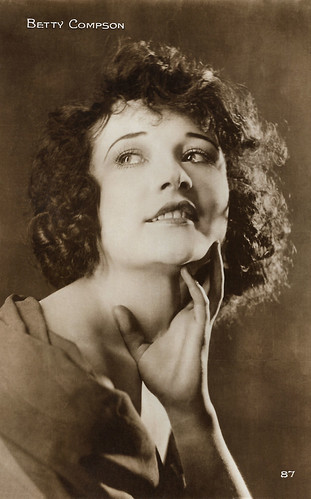
French postcard by Cinémagazine-Edition, Paris, no. 87.
Betty Compson (1897–1974) was an American actress and film producer. She peaked in silent cinema and early talkies, and is best known for her performances as a suicidal prostitute rescued by a stoker (George Bancroft) in The Docks of New York (Joseph Von Sternberg, 1928), and as the manipulative carnival girl Carrie in the part-talkie The Barker (George Fitzmaurice, 1928), the latter earning a nomination for the Academy Award for Best Actress.

French postcard by Cinémagazine-Edition, Paris, no. 89.
Marion Davies (1897-1961) was one of the great comedic actresses of the silent era. She starred in nearly four dozen films between 1917 and 1937.

French postcard by Cinémagazine-Edition, Paris, no. 119. Photo: Sartony.
Georges Vaultier (1885-1926) was a French film actor, known for such films as Koenigsmark (1923), L'enfant roi (1923), Auf Befehl der Pompadour (1924), and Le fantôme du Moulin-Rouge (1925).

French postcard by Editions Cinémagazine, no. 126. John Barrymore in Sherlock Holmes (Albert Parker, 1922).
John Barrymore (1882-1942) was an American stage and screen actor whose rise to superstardom and subsequent decline is one of the legendary tragedies of Hollywood. A member of the most famous generation of the most famous theatrical family in America, he was also its most acclaimed star. He excelled in high drama, in productions of 'Justice' (1916), 'Richard III' (1920) and 'Hamlet' (1922). After a success as Hamlet in London in 1925, Barrymore left the stage for 14 years and instead focused entirely on films.

French postcard by Cinémagazine-Edition, Paris, no. 137.
Lila Lee (1901–1973) was a prominent screen actress, primarily a leading lady, of the silent film and early sound film eras.

French postcard by Editions Cinémagazine, no. 142. Photo: P. Apers.
Elegant French actress Arlette Marchal (1902-1984) started as a fashion model and from the 1950s on she dedicated herself mostly to her fashion enterprise. Between 1922 and 1951 she starred in 41 European and American films.

French postcard by Editions Cinémagazine, no. 163.
American actress Bessie Love (1898-1986) was introduced to the cinema by D.W. Griffith. He also gave the actress her screen name. She played innocent young girls and wholesome leading ladies in silent films and early talkies. Her acting career spanned eight decades, and her role in The Broadway Melody (1929) earned her a nomination for the Oscar for Best Actress.
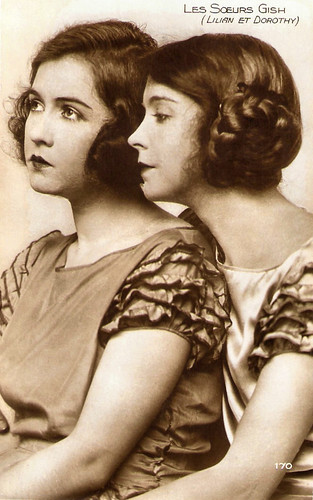
French postcard by Cinémagazine-Edition, Paris, no. 170. Caption: The Gish sisters (Lilian and Dorothy).
American actress Dorothy Gish (1898-1968) and her sister Lilian Gish (1893-1993) were both popular Hollywood stars of the silent era. D.W. Griffith discovered the two girls in 1912 and they starred in his epics Hearts of the World (1918) and Orphans of the Storm (1921).

French postcard by Cinémagazine-Edition, no. 183.
American film actor Tom Mix (1880–1940) was the star of many early Westerns between 1909 and 1935. Mix appeared in 291 films, all but nine of which were silent movies. He was Hollywood's first Western megastar and helped to define the genre for all cowboy actors who followed.
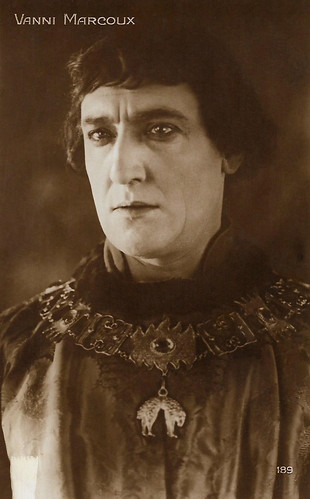
French postcard by Cinémagazine-Edition, no. 189. Vanni Marcoux as Charles le Téméraire (Charles the Bold) in the French silent film Le Miracle des Loups (Raymond Bernard, 1924).
Jean-Émile Diogène Marcoux (1877–1962) was a French operatic bass-baritone, known professionally as Vanni Marcoux (aka Vanni-Marcoux), and renown as one of the most memorable singing-actors of the 20th century. Vanni Marcoux only acted in 4 films, but these were leads as Faust in Don Juan et Faust (Marcel L'Herbier, 1922), as Maurice Ferrioul in the Franco-British coproduction The Scandal (Arthur Rooke, 1923), as Charles le Téméraire in Le Miracle des Loups (Raymond Bernard, 1924), and as Vitalis in Sans famille (Marc Allégret, 1934).

French postcard by Cinémagazine-Edition, Paris, no. 218.
American silent film actress Betty Blythe (1893-1972) was a brunette, buxom matinee idol. She capitalised on the 'roaring 1920s' infatuation with exotic screen sirens to achieve a brief period of stardom. Betty was notorious as one of the first actresses to appear (semi-)nude on screen in The Queen of Sheba (1922). Over the course of her career, she acted in 63 silent and 56 sound films.

French postcard by Cinémagazine-Edition, no. 228. Photo: Gene Kornman.
American actor, comedian, director, producer, screenwriter, and stunt performer Harold Lloyd (1893-1971) is best known for his silent comedies. He ranks alongside Charlie Chaplin and Buster Keaton as one of the three most popular and influential comedians of the silent film. Between 1914 and 1947, Lloyd made nearly 200 comedies, often as a bespectacled 'Glass' character, a resourceful, success-seeking go-getter who was perfectly in tune with 1920s-era United States. His films frequently contained 'thrill sequences' of extended chase scenes and daredevil physical feats. A classic is Lloyd hanging from the hands of a clock high above the street in Safety Last! (1923).

French postcard by Editions Cinémagazine, no. 261. Louise Fazenda was called in France Philomène.
Louise Fazenda (1895-1962) was a gawky, highly popular funny girl in slapstick comedies for Keystone Studios. She paired up well with comedian Charlie Murray. Her best-known character was her country bumpkin - complete with spit curls, multiple pigtails, and calico dresses. In the early 1920s, Louise left Mack Sennett's company and progressed to feature films, where her eccentric talents were greatly utilised in musicals and knockabout comedies.

French postcard by Cinémagazine-Edition, no. 269. Photo: Balazs.
Sturdy and blond Henny Porten (1890-1960) was one of Germany's most important and popular film actresses of the silent cinema. She became the quintessence of German womanhood, ladylike yet kindhearted and a not a little petit bourgeois. She was also the producer of many of her own films.
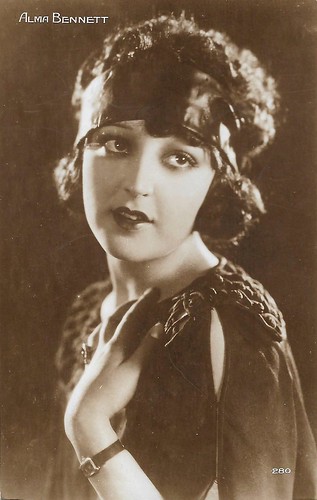
French postcard by Cinémagazine-Edition, no. 280.
Alma Bennett (1904-1958) was an American film actress of the silent era, who appeared in 64 films between 1915 and 1931.

French postcard by Cinémagazine-Edition, no. 281.
Suave and debonair American actor Adolphe Menjou (1890-1963) with his trademark waxy black mustache was one of Hollywood's most distinguished stars and one of America's 'Best Dressed Men'. He started as a matinée idol in the silent cinema in such classics as Ernst Lubitsch's The Marriage Circle (1924). His sound films included Morocco (1931) with Marlene Dietrich and Gary Cooper, A Star is Born (1937), and Stanley Kubrick's Paths of Glory (1957) with Kirk Douglas. In 1931, he was nominated for an Oscar for The Front Page (1931).

French postcard by Cinémagazine-Edition, no. 283. Photo: Paramount. Greta Nissen in The Wanderer (Raoul Walsh, 1925).
Blonde Norwegian-American bombshell Greta Nissen (1906-1988) is mostly remembered for a role she didn't play; or, rather, a role that was eventually re-filmed with someone else.

French postcard by Cinémagazine-Edition, no. 284.
American actor Conrad Nagel (1897-1970) was a tall, blue-eyed matinee idol of the 1920s. He successfully made the transition to sound film.
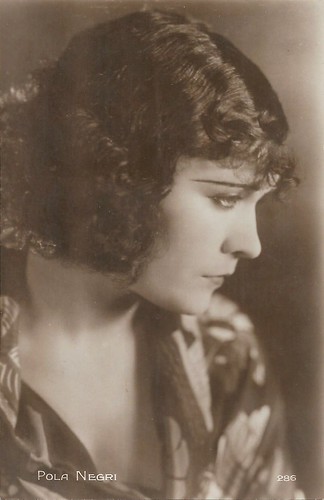
French postcard by Cinémagazine-Edition, Paris, no. 286.
Polish film actress Pola Negri (1897-1987) achieved fame and notoriety as a femme fatale in German and American silent films between the 1910s and 1930s. Negri was an overnight sensation in Ernst Lubitsch' Madame du Barry/Passion (1919). She moved to Hollywood where she lived in a palace, modeled after the White House.

French postcard by Cinémagazine-Edition, Paris, no. 288.
Estelle Taylor (1894–1958) was an American actress, singer, model, and animal rights activist. With her "dark-brown, almost black hair, and brown eyes", she was regarded as one of the most beautiful silent film stars of the 1920s.

French postcard by Cinémagazine-Edition, no. 296. Photo: Evans Studio, L.A.
Enid Bennett (1893-1969) was an Australian-born silent film actress, mostly active in the American cinema. She peaked in the late 1910s and early 1920s with films such as Robin Hood (1922), starring Douglas Fairbanks, and The Sea Hawk (1924). In the sound era, she played Jackie Coogan's mother in the Oscar-winning film Skippy (1931). She was the wife of director Fred Niblo and after his death of director Sidney Franklin.
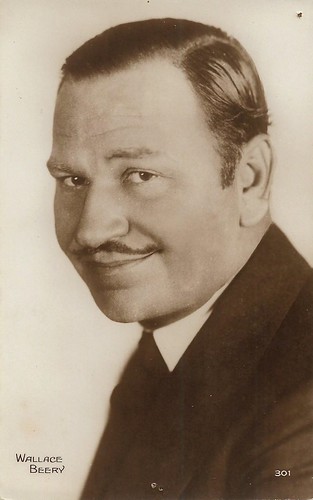
French postcard by Editions Cinémagazine, no. 301.
American actor Wallace Beery (1885-1949) is best known for his portrayal of Bill in Min and Bill opposite Marie Dressler, as Long John Silver in Treasure Island, as Pancho Villa in Viva Villa!, and his titular role in The Champ, for which he won the Academy Award for Best Actor. Beery appeared in some 250 films in a 36-year career. He was the brother of actor Noah Beery, Sr. and uncle of actor Noah Beery, Jr.

French postcard by Editions Cinémagazine, no. 325. Photo: Studio G.L. Manuel Frères.
French actress Dolly Davis (1896-1962) was a very popular comédienne in the 1920s, who was often paired with her then companion André Roanne. They even starred together in a film simply called Dolly (Pierre Colombier, 1928).
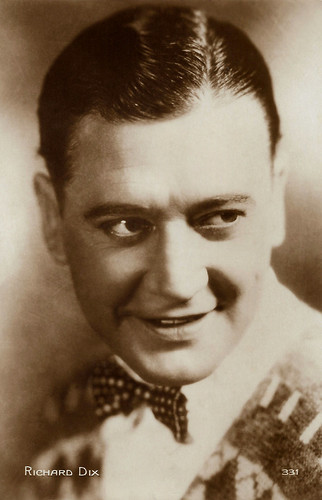
French postcard by Cinémagazine-Edition, Paris, no. 331.
American film actor Richard Dix (1893–1949) achieved popularity in both silent and sound film, first as the rugged and stalwart hero in countless Westerns, then dramatic features such as Cecil B. DeMille's The Ten Commandments (1923). After his years of silent film at Paramount, and thanks to his deep voice and commanding presence, he became a well-known star at RKO in the 1930s. He was nominated for the Academy Award for Best Actor for his lead role in the Best Picture-winning epic, Cimarron (1931).

French postcard by Editions Cinémagazine, no. 332. NB Costello's first name is misspelled on the postcard.
American film actress Dolores Costello (1903-1979) was 'The Goddess of the Silent Screen'. She was Hollywood royalty: the daughter of popular matinee idol Maurice Costello, wife of John Barrymore and grandmother of Drew Barrymore.

French postcard by Editions Cinémagazine, no. 339. Photo: Studio G.L. Manuel Frères.
Spanish actress, singer, and diva Raquel Meller acted mainly in French silent films. She was already a highly popular singer before debuting as a film actress in 1919.

French postcard by Editions Cinémagazine, no. 341.
Suave, dark-haired Ricardo Cortez, born Jacob Krantz or Kranze (1900-1977) was an American screen actor and director, who peaked in the 1920s as Paramount's romantic lover opposite the big female stars of the decade, while in the 1930s he rather played tough men such as the first Sam Spade on the screen.

French postcard by Editions Cinémagazine, no. 346.
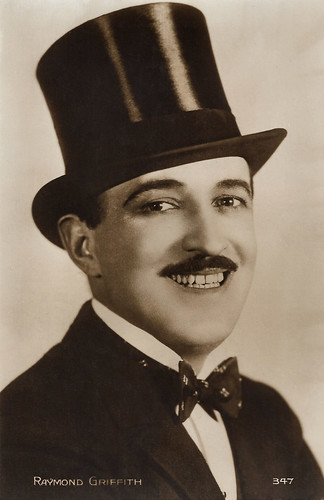
French postcard by Editions Cinémagazine, no. 347.
Raymond Griffith (1895-1957) was an American silent movie comedian, known for films such as Paths to Paradise (1925) and Hands Up! (1926). In the sound era, he worked as production supervisor and associate producer.

French postcard by Cinémagazine-Edition, no. 358. Photo: Evans, L.A.
Clean-cut, sensitive Lloyd Hughes (1897-1958) was an American actor of both the silent and sound film eras. He appeared in such silent classics as Tess of the Storm Country (1921), The Sea Hawk (1924), and The Lost World (1925).

French postcard by Editions Cinémagazine, no. 365.
Camille Bardou (1872-1941) was a French stage and screen actor, who acted in cinema between 1904 and 1934.

French postcard by Editions Cinémagazine, no. 370. Mae Murray in Circe the Enchantress (Robert Z. Leonard, 1924).
American actress and dancer Mae Murray (1885-1965) had her breakthrough on Broadway at the Ziegfeld Follies. Her film debut was in To Have and to Hold (1916). Murray became one of the biggest stars of Universal, often directed by her then-husband, Robert Z. Leonard. At the height of her career, she decided to found her own company with director John Stahl. While the films were successful, critics didn’t like them, because of her exaggerated emotions and her costumes. In the early 1920s, Murray started acting at Metro (later MGM). Murray’s most famous role was that in Erich Von Stroheim’s The Merry Widow (1925), co-starring John Gilbert.

French postcard by Editions Cinémagazine, no. 390. Renée Adorée in The Flaming Forest (Reginald Barker, 1926).
French actress Renée Adorée (1898-1933) appeared in Hollywood in several silent films during the 1920s. She became famous as Melisande in the melodramatic romance and war epic The Big Parade (King Vidor, 1925) opposite John Gilbert. It became one of MGM's all-time biggest hits and is one of the classics of the silent film era. In The Mating Call (1928), produced by Howard Hughes, Adorée had a brief nude swimming scene that caused quite some commotion at the time. With the advent of sound in film, Adorée's voice met the film industry's new needs. But in 1930 she was diagnosed with tuberculosis and died in 1933, just a few days after her 35th birthday.

French postcard by Editions Cinémagazine, no. 391.
Cute and petite American actress Sally O'Neill (1908–1968) acted in almost 50 films between the mid-1920s and the mid-1930s.

French postcard by Editions Cinémagazine, no. 398. Photo: G.L. Manuel Frères.
When Nilda Duplessy entered the film sets in 1922, she had already been a Parisian stage actress for a while, notably in revues by Rip at the theatres Capucines, Femina, and Vaudeville, while she could be seen in Le Bel Ange vint at the Theatre Michel and in Le Tracassin at the Potinière. Remarking her fine beauty, film director Gaston Roudès selected here for Le petit Moineau de Paris (1923), starring Régine Bouet. Not convinced herself, she returned to the stage. Robert Boudrioz called her back to the sets for the more substantial role of Marina de Dasetta opposite Sylvio De Pedrelli in L'Epervier (1925).

French postcard by Cinémagazine-Édition, no. 420. Photo: Sartony.
André Luguet (1892-1979) was a French stage and film actor. He appeared in over 120 films between 1910 and 1970, both in France and Hollywood.
Next Saturday, Part 2.

French postcard by Cinémagazine-Edition, Paris, no. 14.
Pearl White (1889-1938) was dubbed 'Queen of the Serials", and noted for doing her own stunts, in silent film serials such as The Perils of Pauline (1914) and The Exploits of Elaine (1914-15). Many episodes ended with a literal cliffhanger. In Europe, The Exploits of Elaine were re-edited with two subsequent serials into Les Mystères de New York. Until the end of the First World War, White remained globally a popular action heroine.

French postcard by Cinémagazine-Edition, Paris, no. 30.
Alla Nazimova (1879–1945) was a grand, highly flamboyant star of the American silent cinema. The Russian-born film and theatre actress, screenwriter, and film producer was widely known as just Nazimova. On Broadway, she was noted for her work in the classic plays of Ibsen, Chekhov, and Turgenev. Her efforts at silent film production were less successful, but a few sound-film performances survive as a record of her art.

French postcard by Cinémagazine-Edition, Paris, no. 71. Photo: Studio Rahma.
Gabriel de Gravone aka Gabriel de Gravonne (1887-1972) was an actor of French silent cinema. He is most known as Élie, the son of Sisif (Séverin-Mars) in Abel Gance’s La Roue (1920-1923).

French postcard by Cinémagazine-Edition, Paris, no. 87.
Betty Compson (1897–1974) was an American actress and film producer. She peaked in silent cinema and early talkies, and is best known for her performances as a suicidal prostitute rescued by a stoker (George Bancroft) in The Docks of New York (Joseph Von Sternberg, 1928), and as the manipulative carnival girl Carrie in the part-talkie The Barker (George Fitzmaurice, 1928), the latter earning a nomination for the Academy Award for Best Actress.

French postcard by Cinémagazine-Edition, Paris, no. 89.
Marion Davies (1897-1961) was one of the great comedic actresses of the silent era. She starred in nearly four dozen films between 1917 and 1937.

French postcard by Cinémagazine-Edition, Paris, no. 119. Photo: Sartony.
Georges Vaultier (1885-1926) was a French film actor, known for such films as Koenigsmark (1923), L'enfant roi (1923), Auf Befehl der Pompadour (1924), and Le fantôme du Moulin-Rouge (1925).

French postcard by Editions Cinémagazine, no. 126. John Barrymore in Sherlock Holmes (Albert Parker, 1922).
John Barrymore (1882-1942) was an American stage and screen actor whose rise to superstardom and subsequent decline is one of the legendary tragedies of Hollywood. A member of the most famous generation of the most famous theatrical family in America, he was also its most acclaimed star. He excelled in high drama, in productions of 'Justice' (1916), 'Richard III' (1920) and 'Hamlet' (1922). After a success as Hamlet in London in 1925, Barrymore left the stage for 14 years and instead focused entirely on films.

French postcard by Cinémagazine-Edition, Paris, no. 137.
Lila Lee (1901–1973) was a prominent screen actress, primarily a leading lady, of the silent film and early sound film eras.

French postcard by Editions Cinémagazine, no. 142. Photo: P. Apers.
Elegant French actress Arlette Marchal (1902-1984) started as a fashion model and from the 1950s on she dedicated herself mostly to her fashion enterprise. Between 1922 and 1951 she starred in 41 European and American films.

French postcard by Editions Cinémagazine, no. 163.
American actress Bessie Love (1898-1986) was introduced to the cinema by D.W. Griffith. He also gave the actress her screen name. She played innocent young girls and wholesome leading ladies in silent films and early talkies. Her acting career spanned eight decades, and her role in The Broadway Melody (1929) earned her a nomination for the Oscar for Best Actress.

French postcard by Cinémagazine-Edition, Paris, no. 170. Caption: The Gish sisters (Lilian and Dorothy).
American actress Dorothy Gish (1898-1968) and her sister Lilian Gish (1893-1993) were both popular Hollywood stars of the silent era. D.W. Griffith discovered the two girls in 1912 and they starred in his epics Hearts of the World (1918) and Orphans of the Storm (1921).

French postcard by Cinémagazine-Edition, no. 183.
American film actor Tom Mix (1880–1940) was the star of many early Westerns between 1909 and 1935. Mix appeared in 291 films, all but nine of which were silent movies. He was Hollywood's first Western megastar and helped to define the genre for all cowboy actors who followed.

French postcard by Cinémagazine-Edition, no. 189. Vanni Marcoux as Charles le Téméraire (Charles the Bold) in the French silent film Le Miracle des Loups (Raymond Bernard, 1924).
Jean-Émile Diogène Marcoux (1877–1962) was a French operatic bass-baritone, known professionally as Vanni Marcoux (aka Vanni-Marcoux), and renown as one of the most memorable singing-actors of the 20th century. Vanni Marcoux only acted in 4 films, but these were leads as Faust in Don Juan et Faust (Marcel L'Herbier, 1922), as Maurice Ferrioul in the Franco-British coproduction The Scandal (Arthur Rooke, 1923), as Charles le Téméraire in Le Miracle des Loups (Raymond Bernard, 1924), and as Vitalis in Sans famille (Marc Allégret, 1934).

French postcard by Cinémagazine-Edition, Paris, no. 218.
American silent film actress Betty Blythe (1893-1972) was a brunette, buxom matinee idol. She capitalised on the 'roaring 1920s' infatuation with exotic screen sirens to achieve a brief period of stardom. Betty was notorious as one of the first actresses to appear (semi-)nude on screen in The Queen of Sheba (1922). Over the course of her career, she acted in 63 silent and 56 sound films.

French postcard by Cinémagazine-Edition, no. 228. Photo: Gene Kornman.
American actor, comedian, director, producer, screenwriter, and stunt performer Harold Lloyd (1893-1971) is best known for his silent comedies. He ranks alongside Charlie Chaplin and Buster Keaton as one of the three most popular and influential comedians of the silent film. Between 1914 and 1947, Lloyd made nearly 200 comedies, often as a bespectacled 'Glass' character, a resourceful, success-seeking go-getter who was perfectly in tune with 1920s-era United States. His films frequently contained 'thrill sequences' of extended chase scenes and daredevil physical feats. A classic is Lloyd hanging from the hands of a clock high above the street in Safety Last! (1923).

French postcard by Editions Cinémagazine, no. 261. Louise Fazenda was called in France Philomène.
Louise Fazenda (1895-1962) was a gawky, highly popular funny girl in slapstick comedies for Keystone Studios. She paired up well with comedian Charlie Murray. Her best-known character was her country bumpkin - complete with spit curls, multiple pigtails, and calico dresses. In the early 1920s, Louise left Mack Sennett's company and progressed to feature films, where her eccentric talents were greatly utilised in musicals and knockabout comedies.

French postcard by Cinémagazine-Edition, no. 269. Photo: Balazs.
Sturdy and blond Henny Porten (1890-1960) was one of Germany's most important and popular film actresses of the silent cinema. She became the quintessence of German womanhood, ladylike yet kindhearted and a not a little petit bourgeois. She was also the producer of many of her own films.

French postcard by Cinémagazine-Edition, no. 280.
Alma Bennett (1904-1958) was an American film actress of the silent era, who appeared in 64 films between 1915 and 1931.

French postcard by Cinémagazine-Edition, no. 281.
Suave and debonair American actor Adolphe Menjou (1890-1963) with his trademark waxy black mustache was one of Hollywood's most distinguished stars and one of America's 'Best Dressed Men'. He started as a matinée idol in the silent cinema in such classics as Ernst Lubitsch's The Marriage Circle (1924). His sound films included Morocco (1931) with Marlene Dietrich and Gary Cooper, A Star is Born (1937), and Stanley Kubrick's Paths of Glory (1957) with Kirk Douglas. In 1931, he was nominated for an Oscar for The Front Page (1931).

French postcard by Cinémagazine-Edition, no. 283. Photo: Paramount. Greta Nissen in The Wanderer (Raoul Walsh, 1925).
Blonde Norwegian-American bombshell Greta Nissen (1906-1988) is mostly remembered for a role she didn't play; or, rather, a role that was eventually re-filmed with someone else.

French postcard by Cinémagazine-Edition, no. 284.
American actor Conrad Nagel (1897-1970) was a tall, blue-eyed matinee idol of the 1920s. He successfully made the transition to sound film.

French postcard by Cinémagazine-Edition, Paris, no. 286.
Polish film actress Pola Negri (1897-1987) achieved fame and notoriety as a femme fatale in German and American silent films between the 1910s and 1930s. Negri was an overnight sensation in Ernst Lubitsch' Madame du Barry/Passion (1919). She moved to Hollywood where she lived in a palace, modeled after the White House.

French postcard by Cinémagazine-Edition, Paris, no. 288.
Estelle Taylor (1894–1958) was an American actress, singer, model, and animal rights activist. With her "dark-brown, almost black hair, and brown eyes", she was regarded as one of the most beautiful silent film stars of the 1920s.

French postcard by Cinémagazine-Edition, no. 296. Photo: Evans Studio, L.A.
Enid Bennett (1893-1969) was an Australian-born silent film actress, mostly active in the American cinema. She peaked in the late 1910s and early 1920s with films such as Robin Hood (1922), starring Douglas Fairbanks, and The Sea Hawk (1924). In the sound era, she played Jackie Coogan's mother in the Oscar-winning film Skippy (1931). She was the wife of director Fred Niblo and after his death of director Sidney Franklin.

French postcard by Editions Cinémagazine, no. 301.
American actor Wallace Beery (1885-1949) is best known for his portrayal of Bill in Min and Bill opposite Marie Dressler, as Long John Silver in Treasure Island, as Pancho Villa in Viva Villa!, and his titular role in The Champ, for which he won the Academy Award for Best Actor. Beery appeared in some 250 films in a 36-year career. He was the brother of actor Noah Beery, Sr. and uncle of actor Noah Beery, Jr.

French postcard by Editions Cinémagazine, no. 325. Photo: Studio G.L. Manuel Frères.
French actress Dolly Davis (1896-1962) was a very popular comédienne in the 1920s, who was often paired with her then companion André Roanne. They even starred together in a film simply called Dolly (Pierre Colombier, 1928).

French postcard by Cinémagazine-Edition, Paris, no. 331.
American film actor Richard Dix (1893–1949) achieved popularity in both silent and sound film, first as the rugged and stalwart hero in countless Westerns, then dramatic features such as Cecil B. DeMille's The Ten Commandments (1923). After his years of silent film at Paramount, and thanks to his deep voice and commanding presence, he became a well-known star at RKO in the 1930s. He was nominated for the Academy Award for Best Actor for his lead role in the Best Picture-winning epic, Cimarron (1931).

French postcard by Editions Cinémagazine, no. 332. NB Costello's first name is misspelled on the postcard.
American film actress Dolores Costello (1903-1979) was 'The Goddess of the Silent Screen'. She was Hollywood royalty: the daughter of popular matinee idol Maurice Costello, wife of John Barrymore and grandmother of Drew Barrymore.

French postcard by Editions Cinémagazine, no. 339. Photo: Studio G.L. Manuel Frères.
Spanish actress, singer, and diva Raquel Meller acted mainly in French silent films. She was already a highly popular singer before debuting as a film actress in 1919.

French postcard by Editions Cinémagazine, no. 341.
Suave, dark-haired Ricardo Cortez, born Jacob Krantz or Kranze (1900-1977) was an American screen actor and director, who peaked in the 1920s as Paramount's romantic lover opposite the big female stars of the decade, while in the 1930s he rather played tough men such as the first Sam Spade on the screen.

French postcard by Editions Cinémagazine, no. 346.

French postcard by Editions Cinémagazine, no. 347.
Raymond Griffith (1895-1957) was an American silent movie comedian, known for films such as Paths to Paradise (1925) and Hands Up! (1926). In the sound era, he worked as production supervisor and associate producer.

French postcard by Cinémagazine-Edition, no. 358. Photo: Evans, L.A.
Clean-cut, sensitive Lloyd Hughes (1897-1958) was an American actor of both the silent and sound film eras. He appeared in such silent classics as Tess of the Storm Country (1921), The Sea Hawk (1924), and The Lost World (1925).

French postcard by Editions Cinémagazine, no. 365.
Camille Bardou (1872-1941) was a French stage and screen actor, who acted in cinema between 1904 and 1934.

French postcard by Editions Cinémagazine, no. 370. Mae Murray in Circe the Enchantress (Robert Z. Leonard, 1924).
American actress and dancer Mae Murray (1885-1965) had her breakthrough on Broadway at the Ziegfeld Follies. Her film debut was in To Have and to Hold (1916). Murray became one of the biggest stars of Universal, often directed by her then-husband, Robert Z. Leonard. At the height of her career, she decided to found her own company with director John Stahl. While the films were successful, critics didn’t like them, because of her exaggerated emotions and her costumes. In the early 1920s, Murray started acting at Metro (later MGM). Murray’s most famous role was that in Erich Von Stroheim’s The Merry Widow (1925), co-starring John Gilbert.

French postcard by Editions Cinémagazine, no. 390. Renée Adorée in The Flaming Forest (Reginald Barker, 1926).
French actress Renée Adorée (1898-1933) appeared in Hollywood in several silent films during the 1920s. She became famous as Melisande in the melodramatic romance and war epic The Big Parade (King Vidor, 1925) opposite John Gilbert. It became one of MGM's all-time biggest hits and is one of the classics of the silent film era. In The Mating Call (1928), produced by Howard Hughes, Adorée had a brief nude swimming scene that caused quite some commotion at the time. With the advent of sound in film, Adorée's voice met the film industry's new needs. But in 1930 she was diagnosed with tuberculosis and died in 1933, just a few days after her 35th birthday.

French postcard by Editions Cinémagazine, no. 391.
Cute and petite American actress Sally O'Neill (1908–1968) acted in almost 50 films between the mid-1920s and the mid-1930s.

French postcard by Editions Cinémagazine, no. 398. Photo: G.L. Manuel Frères.
When Nilda Duplessy entered the film sets in 1922, she had already been a Parisian stage actress for a while, notably in revues by Rip at the theatres Capucines, Femina, and Vaudeville, while she could be seen in Le Bel Ange vint at the Theatre Michel and in Le Tracassin at the Potinière. Remarking her fine beauty, film director Gaston Roudès selected here for Le petit Moineau de Paris (1923), starring Régine Bouet. Not convinced herself, she returned to the stage. Robert Boudrioz called her back to the sets for the more substantial role of Marina de Dasetta opposite Sylvio De Pedrelli in L'Epervier (1925).

French postcard by Cinémagazine-Édition, no. 420. Photo: Sartony.
André Luguet (1892-1979) was a French stage and film actor. He appeared in over 120 films between 1910 and 1970, both in France and Hollywood.
Next Saturday, Part 2.
No comments:
Post a Comment